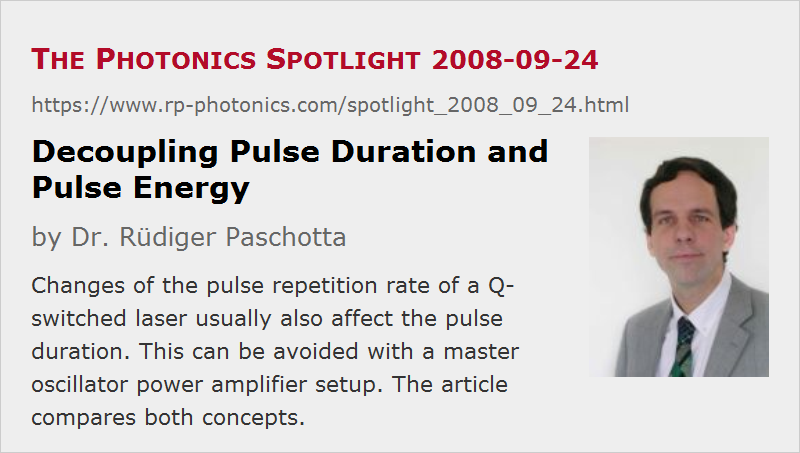Decoupling Pulse Duration and Pulse Energy
Posted on 2008-09-24 as a part of the Photonics Spotlight (available as e-mail newsletter!)
Permanent link: https://www.rp-photonics.com/spotlight_2008_09_24.html
Author: Dr. Rüdiger Paschotta, RP Photonics Consulting GmbH
Abstract: Changes of the pulse repetition rate of a Q-switched laser usually also affect the pulse duration. This can be avoided with a master oscillator power amplifier setup. The article compares both concepts.

Ref.: encyclopedia articles on Q-switched lasers, master oscillator fiber amplifier
When the pulse repetition rate of an actively Q-switched laser is increased, while the (continuously applied) pump power remains constant, the pulse energy is reduced. An important side effect of this is that the pulse duration is increased. Therefore, the peak power is reduced even more, as it depends on both the pulse energy and the pulse duration. As a rule of thumb, which is normally quite precise for repetition rates above the inverse upper-state lifetime of the gain medium, a doubling of the repetition rate will reduce the pulse energy to one half the original value, double the pulse duration, and reduce the peak power by a factor of 4.
That relation between pulse repetition rate and duration is undesirable for some laser applications e.g. in the area of laser material processing. A change in repetition rate alone usually has the simple effect of linearly rescaling the processing time, assuming that the workpiece fully recovers between subsequent pulses. The additional change of pulse duration, however, can have effects which are difficult to predict.
A possible solution is to generate the pulses not with a Q-switched laser, but rather with a master oscillator power amplifier (MOPA) setup. If the amplifier is a fiber amplifier, the device may also be called master oscillator fiber amplifier (MOFA). (Some even call it a fiber laser.) The seed laser of such a device may be a laser diode. The seed pulse duration can simply be controlled via the electronic driver. Possible gain saturation effects in the amplifier can be compensated by adjusting the duration and possibly also the temporal shape of the seed pulses. Effectively, it becomes possible to decouple the pulse duration from the pulse energy. This can be very useful in cases where the repetition rate needs to be changed all the time, or some finite pulse trains are needed with larger temporal gaps in between, and each pulse (including the first one in each burst) needs to have well controlled parameters.
Unfortunately, that change of system architecture can also have disadvantages. A possible issue at least for fiber amplifiers is that fiber nonlinearities and the possibility of damage set limits to the peak power which can be generated that way. Also, such a MOPA has a high gain, and is thus very sensitive to backreflected light.
It depends on the circumstances which of the two concepts is better suited. A conventional Q-switched laser may be preferable when a variation of repetition rate is not required, or when a very high pulse energy is needed. On the other hand, the flexibility of a fiber-based MOPA may be very desirable particularly for the development of new applications. One may even easily experiment with different temporal pulse shapes.
This article is a posting of the Photonics Spotlight, authored by Dr. Rüdiger Paschotta. You may link to this page and cite it, because its location is permanent. See also the RP Photonics Encyclopedia.
Note that you can also receive the articles in the form of a newsletter or with an RSS feed.
Questions and Comments from Users
Here you can submit questions and comments. As far as they get accepted by the author, they will appear above this paragraph together with the author’s answer. The author will decide on acceptance based on certain criteria. Essentially, the issue must be of sufficiently broad interest.
Please do not enter personal data here; we would otherwise delete it soon. (See also our privacy declaration.) If you wish to receive personal feedback or consultancy from the author, please contact him e.g. via e-mail.
By submitting the information, you give your consent to the potential publication of your inputs on our website according to our rules. (If you later retract your consent, we will delete those inputs.) As your inputs are first reviewed by the author, they may be published with some delay.
 |



If you like this page, please share the link with your friends and colleagues, e.g. via social media:
These sharing buttons are implemented in a privacy-friendly way!